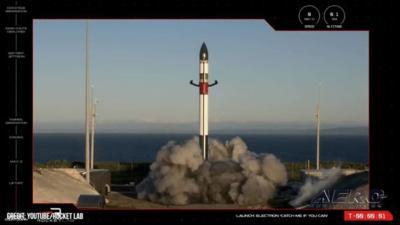Electron Rocket Continues to Impress
Rocket Lab, the publicly traded, American space-launch concern with a New Zealand subsidiary, announced on 17 March 2023 that it will launch a pair of satellites on a dedicated mission of its Electron rocket—a proper noun, not an allusion to the contraption’s workings—for BlackSky, the geospatial intelligence subsidiary of global launch services provider Spaceflight, Inc. The slated mission’s launch window opens 22 March at approximately 16:30 EDT.

The upcoming mission—which will launch two of BlackSky’s Gen-2 Earth-imaging satellites from Rocket Lab’s Launch Complex 1 in Mahia, New Zealand to a circular 450-kilometer orbit—has been dubbed The Beat Goes On. The moniker instantiates Rocket Lab’s propensity for ascribing its missions apt but unconventional appellations. Former Rocket Lab launches have gone by sobriquets the likes of: Look Ma, No Hands, Don’t Stop Me Now, and There and Back Again.
The successful completion of the The Beat Goes On mission will bring the total number of satellites delivered to orbit by Rocket Lab’s Electron rocket platform to 159.
The pair of high-resolution, multi-spectral, Gen-2 satellites to be borne aboard and deployed via the The Beat Goes On mission will expand BlackSky’s constellation to 16 total satellites and supplement the company’s offering of real-time geospatial intelligence and monitoring services. BlackSky combines high-resolution images captured by its constellation of microsatellites with proprietary artificial intelligence software for purpose of delivering analytics and insights to sectors such as transportation, infrastructure, land use, defense, supply chain management, and humanitarian aid.

As a secondary aspect of the The Beat Goes On mission, Rocket Lab plans to recover the Electron rocket’s first-stage after it splashes down under parachute in the Pacific Ocean. Utilizing a customized ship, Rocket Lab’s recovery team will retrieve the reusable first-stage and transport it to the company’s production complex for examination. Data deriving of the recovered first-stage’s analysis will inform Rocket Lab’s ongoing recovery and reuse program.
Rocket Lab founder and Chief Executive Peter Beck stated: “We’re proud to continue playing a key role in building out BlackSky’s growing constellation. We’ve now delivered nine satellites to orbit for BlackSky since our first launch for them in 2019 and we’re grateful to have been entrusted with their mission once again. Counting down to another mission just six days after a successful launch from LC-2 in Virginia is no mean feat and testament to our team’s experience and dedication to delivering response launch.”
To complement its Electron platform, Rocket Lab is developing the larger Neutron rocket, a reusable, medium-lift, two-stage launch vehicle capable of delivering an 8,000-kilogram (17,600 pound) payload to low Earth orbit. The company is also in the process of creating a new satellite-bus called Photon, by which Rocket Lab’s customers may eventually convey satellites to orbits around Earth’s moon and celestial bodies within the Sol system.
 ANN's Daily Aero-Linx (05.02.24)
ANN's Daily Aero-Linx (05.02.24) ANN's Daily Aero-Term (05.02.24): Touchdown Zone Lighting
ANN's Daily Aero-Term (05.02.24): Touchdown Zone Lighting Aero-News: Quote of the Day (05.02.24)
Aero-News: Quote of the Day (05.02.24) ANN FAQ: Contributing To Aero-TV
ANN FAQ: Contributing To Aero-TV NTSB Final Report: Cirrus Design Corp SR20
NTSB Final Report: Cirrus Design Corp SR20




